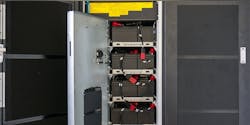When it comes to energy efficiency, data centers are in a league of their own. Power density in these mission critical facilities doubles nearly every 18 months and uptime reliability is a higher priority than energy efficiency, says Mukul Anand, Manager of Application Engineering, Chiller Solutions, Building Technologies and Solutions for Johnson Controls, Inc.
“From an energy reduction viewpoint, data centers are a unique moving target,” Anand explains. “There is no well-defined method to improve energy efficiency.” These three savings strategies can be a good start, however.
1) Equipment Optimization
About 60% of the energy consumption in a typical data center is used for computer-related components, such as processors, fans and data storage, Anand explains. Another 30% goes to cooling equipment, with 10% dedicated to electrical equipment and the remaining 2% for lighting, monitors and other components for data center infrastructure management. That means that tackling just the first category, computing equipment, could result in considerable savings.
The U.S. Department of Energy recommends starting by turning off any unused servers, often referred to as “comatose” or “zombie” servers, as 20-30% of servers in a typical data center are consuming power, cooling and space without doing any useful work. Take a regular inventory of hardware and applications so you can keep track of consolidation opportunities, then build on the savings with virtualization software and more efficient servers.
“State-of-the-art servers provide the most benefit because they have an energy multiplier effect,” Anand says. “Every kW saved at the server translates into a proportional reduction in BTUs because less heat needs to be removed.”
2) Building System Savings
After ensuring your computing equipment is as efficient as possible, look at possible savings in building systems, especially cooling. Using advanced data center infrastructure management (DCIM) and building management software can assist with efficient cooling by enhancing equipment operation and providing monitoring to help you make informed decisions, Anand says.
“Right-sizing infrastructure equipment to handle design and off-design conditions also contributes to energy savings,” Anand adds. “For example, a variable speed drive chiller can run more efficiently during 99% of operating hours in low-load conditions than a chiller designed for full-speed operation for the hottest days of the year. For a variety of reasons, it pays to right-size air handling units, UPS and transformer equipment.”
The DOE also recommends variable speed drives on cooling system fans, noting that a 20% reduction in flow results in roughly 50% savings in fan power.
3) Layout
“Hot aisle containment is generally the most efficient way to arrange the racks within data centers because it ensures that in the working space, the temperature falls within the ASHRAE guidelines,” Anand says. Hot air is exhausted into the hot aisle, where it circulates back to the CRAH unit for cooling. This allows the CRAH unit to operate at the capacity it was designed for and also lets you right-size the number of units. Use blanking plates, floor tiles and other devices to make sure air doesn’t leak between cold and hot aisles, Anand recommends.
For persistent hot spots, the DOE recommends providing spot cooling via in-rack or in-row cooling devices. Rear door heat exchangers are another innovative option that involves installing a coil on the server rack’s exhaust section to absorb the heat and provide cooling. Air-side economizers that draw in outside air are a great option in the right climate zones.
Janelle Penny [email protected] is Senior Editor of BUILDINGS.
About the Author
Janelle Penny
Editor-in-Chief at BUILDINGS
Janelle Penny has been with BUILDINGS since 2010. She is a two-time FOLIO: Eddie award winner who aims to deliver practical, actionable content for building owners and facilities professionals.

